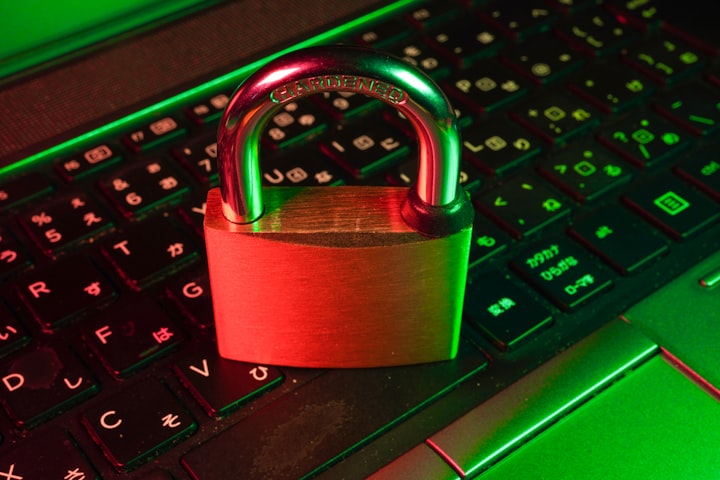Secure Your Online Business Transactions with These Banking Login Best Practices
All about security
In today’s digital age, online banking has become increasingly popular, especially for businesses. With the convenience of online banking comes the risk of cyber-attacks and fraud. It's crucial to take extra precautions to protect your online business transactions. In this blog post, we will be discussing the best practices for banking logins to help you secure your online transactions. These practices include using a unique username and password, two-factor authentication, and avoiding public Wi-Fi. By following these best practices, you can ensure that your online financial information is secure, and you can focus on growing your business with peace of mind.
1. Introduction to the importance of secure online banking
In today's digital age, online banking has become an essential part of our lives. It is a convenient and hassle-free way to pay bills, transfer funds, and manage our finances. However, with the convenience of online banking comes the risk of cyber threats and frauds. Online banking frauds are on the rise, and they can lead to significant financial losses. Therefore, it is crucial to take precautions to ensure the security of your online banking transactions.
One of the most effective ways to secure your online banking transactions is to follow the best practices for banking logins. These practices can help protect your personal and financial information from hackers and fraudsters. By following these best practices, you can have peace of mind knowing that your online banking transactions are safe and secure. In this blog post, we will discuss some of the best practices for online banking logins that you can follow to protect your financial information.
2. Best practices to follow when creating a banking login
Creating a strong and secure banking login is crucial to ensuring the safety of your online business transactions. Here are a few best practices that you should follow when creating your banking login:
1. Use a strong and unique password: Your password should be at least 12 characters long and should include a mix of uppercase and lowercase letters, numbers, and symbols. Avoid using common phrases or easily guessable information such as your name or date of birth. It's also important to use a different password for each account to prevent a security breach.
2. Enable two-factor authentication: Two-factor authentication adds an extra layer of security to your login process and requires you to provide a second form of verification such as a code sent to your phone or email. This ensures that even if someone gets hold of your password, they won't be able to access your account without the second form of verification.
3. Use a trusted device: Only log in to your banking account from a trusted device, and avoid using public Wi-Fi or shared computers. These can be easily compromised, and your login details can be stolen.
4. Keep your login details private: Never share your login details with anyone, including family members or friends. Banks will never ask you for your login details, so if you receive any such requests, it's likely a scam.
Following these best practices can help you create a strong and secure banking login, protecting your online business transactions from potential threats.
3. How to create and manage a strong password
Creating a strong password is one of the most basic yet important steps in securing your online business transactions. A strong password is one that is difficult for others to guess, but easy for you to remember. Here are a few tips to create and manage a strong password:
1. Use a mix of upper and lowercase letters, numbers, and symbols in your password.
2. Avoid using personal information such as dates of birth, addresses, or family member names.
3. Use a passphrase that is easy to remember but difficult for others to guess. For example, "MyFav0riteC0l0rIsBlu3!" is a strong passphrase.
4. Don't reuse passwords across different platforms. If one password is compromised, it can lead to all your accounts being compromised.
5. Use a password manager to generate and store complex passwords. This can help you remember multiple passwords without having to write them down or store them in an unsecured location.
Managing your password is also important. Here are some tips to effectively manage your passwords and keep them secure:
1. Change your password frequently. This can prevent unauthorized access to your account.
2. Enable two-factor authentication whenever possible. This adds an extra layer of security to your login process.
3. Don't share your password with anyone. This includes family members, colleagues, or even customer support representatives.
4. Always log out of your account when you're finished. This can prevent unauthorized access to your account if someone gains access to your device.
By following these best practices, you can create and manage strong passwords that will help secure your online business transactions and protect your sensitive information.
4. The importance of multi-factor authentication
The importance of multi-factor authentication cannot be overstated when it comes to securing your online business transactions. Multi-factor authentication is a security mechanism that requires users to provide two or more forms of authentication before gaining access to an account. This could be a combination of something that the user knows, like a password or PIN, something the user has, like a smart card or token, or something the user is, like a fingerprint or facial recognition.
By implementing multi-factor authentication, you can significantly reduce the risk of unauthorized access to your business accounts, even if your password is compromised. With multiple layers of security, it becomes much more difficult for hackers to gain access to your sensitive business information.
It's also important to note that not all multi-factor authentication methods are created equal. Some methods, like SMS-based authentication, have been shown to be vulnerable to attacks. It's always best to choose a multi-factor authentication method that is secure and reliable.
In summary, multi-factor authentication is an essential best practice for securing your online business transactions. By implementing this security measure, you can significantly reduce the risk of unauthorized access and protect your business from potential threats.
5. Avoiding common mistakes when logging in
When it comes to logging into your online banking account, there are a few common mistakes that you should avoid to ensure the security of your transactions. One mistake is using public Wi-Fi networks to log in. Public Wi-Fi networks are not secure and hackers can easily intercept your login credentials and gain access to your account. Always use a secure and private network to log in to your online banking account.
Another mistake to avoid is using weak passwords or reusing the same password for multiple accounts. Weak passwords are easy for hackers to guess, while reused passwords can give them access to multiple accounts if one account is compromised. Always use strong and unique passwords for each of your accounts and consider using a password manager to keep track of them.
Phishing scams are another common mistake to avoid. These scams involve hackers creating fake websites or emails that look like they are from your bank, but are actually designed to steal your login credentials. Always verify the authenticity of any emails or websites before entering your login information. Check for the SSL certificate, look for the padlock icon in the address bar, and double-check the URL to ensure you are on the correct website.
By avoiding these common mistakes and following best practices for logging in, you can help to secure your online banking transactions and protect your sensitive information from hackers.
6. Keeping your devices secure and up-to-date
Keeping your devices secure and up-to-date is crucial in ensuring the safety of your online business transactions. Hackers and cybercriminals are constantly looking for vulnerabilities in systems, and outdated software and operating systems are easy targets.
Regularly updating your devices and software, including antivirus and anti-malware software, is a simple but important step in protecting your banking logins and other sensitive information. Set up automatic updates whenever possible, and make sure to apply updates as soon as they become available.
In addition to keeping your devices up-to-date, it's important to be mindful of the security of your devices themselves. Use strong passwords and enable two-factor authentication whenever possible to add an extra layer of protection to your logins. Avoid clicking on suspicious links or downloading files from unknown sources, as these can often contain malware or viruses that can compromise your device's security.
By taking these simple steps to keep your devices secure and up-to-date, you can help prevent cyber attacks and secure your online business transactions.
7. Checking your accounts regularly for unusual activity
One of the best practices to secure your online business transactions is by checking your accounts regularly for any unusual activity. This should be done at least once a week to ensure that all transactions made are legitimate and there are no unauthorized transactions.
If you notice any unusual activity or transactions that you did not make, immediately report it to your bank or credit card issuer. Most banks have a fraud department that can help you resolve any fraudulent activities on your account.
It is also important to check your account balances regularly to ensure that you have enough funds to cover the transactions you have made. This can help you avoid overdraft fees and other charges that may be incurred due to insufficient funds.
In addition, make sure that you are receiving your account statements regularly and review them thoroughly. Check for any errors or discrepancies and report them to your bank or credit card issuer as soon as possible.
By regularly monitoring your accounts, you can detect fraudulent activity early on and take immediate action to prevent any further damage to your online business transactions.
8. How to recognize and avoid phishing scams
In today's online world, phishing scams have become a major threat to online banking users. Phishing scams are fraudulent attempts to obtain sensitive information, such as usernames, passwords, and credit card details, by disguising as a trustworthy entity in an electronic communication such as an email or a text message.
It is important to know how to recognize and avoid these scams to protect yourself and your business from potential financial and reputational damages.
Here are some tips to help you identify and prevent phishing scams:
1. Check the sender's email address: Phishing emails often come from fake email addresses that may look similar to legitimate ones. Always check the sender's email address and verify it before clicking on any links or attachments.
2. Beware of urgent or threatening language: Phishing scams often use urgent or threatening language to create a sense of urgency and panic in the recipient. Be cautious of any email that creates unnecessary pressure or fear.
3. Verify the authenticity of the website: Always verify the authenticity of the website before entering any sensitive information. Check the URL and look for the padlock icon in the address bar to ensure that you are on a secure website.
4. Never share sensitive information: Avoid sharing your sensitive information such as passwords, credit card details, or social security number via email or phone. Legitimate institutions will never ask you to provide sensitive information this way.
By following these best practices, you can protect your business transactions and prevent falling victim to phishing scams.
9. The benefits of using a virtual private network (VPN)
When it comes to securing your online business transactions, using a Virtual Private Network (VPN) can be an effective tool. A VPN encrypts your internet traffic and routes it through a remote server, making it difficult for anyone to intercept and monitor your online activities. By using a VPN, you can protect your sensitive business information, such as bank login credentials, from cybercriminals who may be lurking on public Wi-Fi networks or other unsecured internet connections.
One of the key benefits of using a VPN is that it helps to keep your online activities private and anonymous. If you're accessing your business bank account or making transactions online, you don't want anyone to be able to trace your IP address or monitor your actions. By using a VPN, you can mask your IP address and make it virtually impossible for anyone to track your online activities.
Another benefit of using a VPN is that it can help you bypass geographical restrictions. If you're traveling abroad and need to access your business bank account, you may encounter restrictions on certain websites or services. By using a VPN, you can connect to a server in your home country and access the internet as if you were still located there. This can be a valuable tool for businesses that have employees who travel frequently or work remotely.
In summary, using a VPN is an effective way to secure your online business transactions and protect your sensitive information from cybercriminals. By keeping your online activities private and anonymous, and bypassing geographical restrictions, a VPN can help you conduct business securely and efficiently from anywhere in the world.
10. Conclusion and final thoughts on securing online banking transactions.
In conclusion, securing your online banking transactions should be a top priority for any business that operates online. By implementing the best practices we've discussed, you can significantly reduce the chances of falling victim to cybercrime.
It's important to remember that cyber threats are constantly evolving, and attackers are becoming more sophisticated in their methods. Therefore, it's essential to stay up-to-date with the latest security trends and technologies to keep your business safe.
Remember to never share your login credentials with anyone and always use strong, unique passwords. Utilize two-factor authentication and keep an eye out for phishing scams. Regularly monitor your accounts for any suspicious activity and report any unauthorized transactions immediately.
By following these best practices and staying vigilant, you can protect your online business from cyber threats and keep your transactions secure. With the right measures in place, you can provide your customers with peace of mind and build a trustworthy reputation for your business.
We hope you found our blog about banking login best practices helpful in securing your online business transactions. Online security is a major concern for any business owner, and taking the right steps to protect yourself and your assets is crucial. By following the tips we've outlined, you can ensure that your banking login information remains safe and secure, and that your online transactions are protected. Thank you for reading, and stay safe online!






Comments
There are no comments for this story
Be the first to respond and start the conversation.